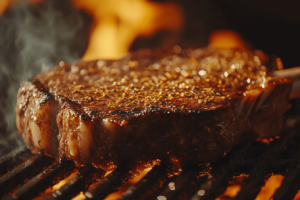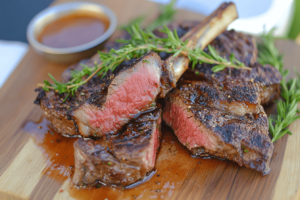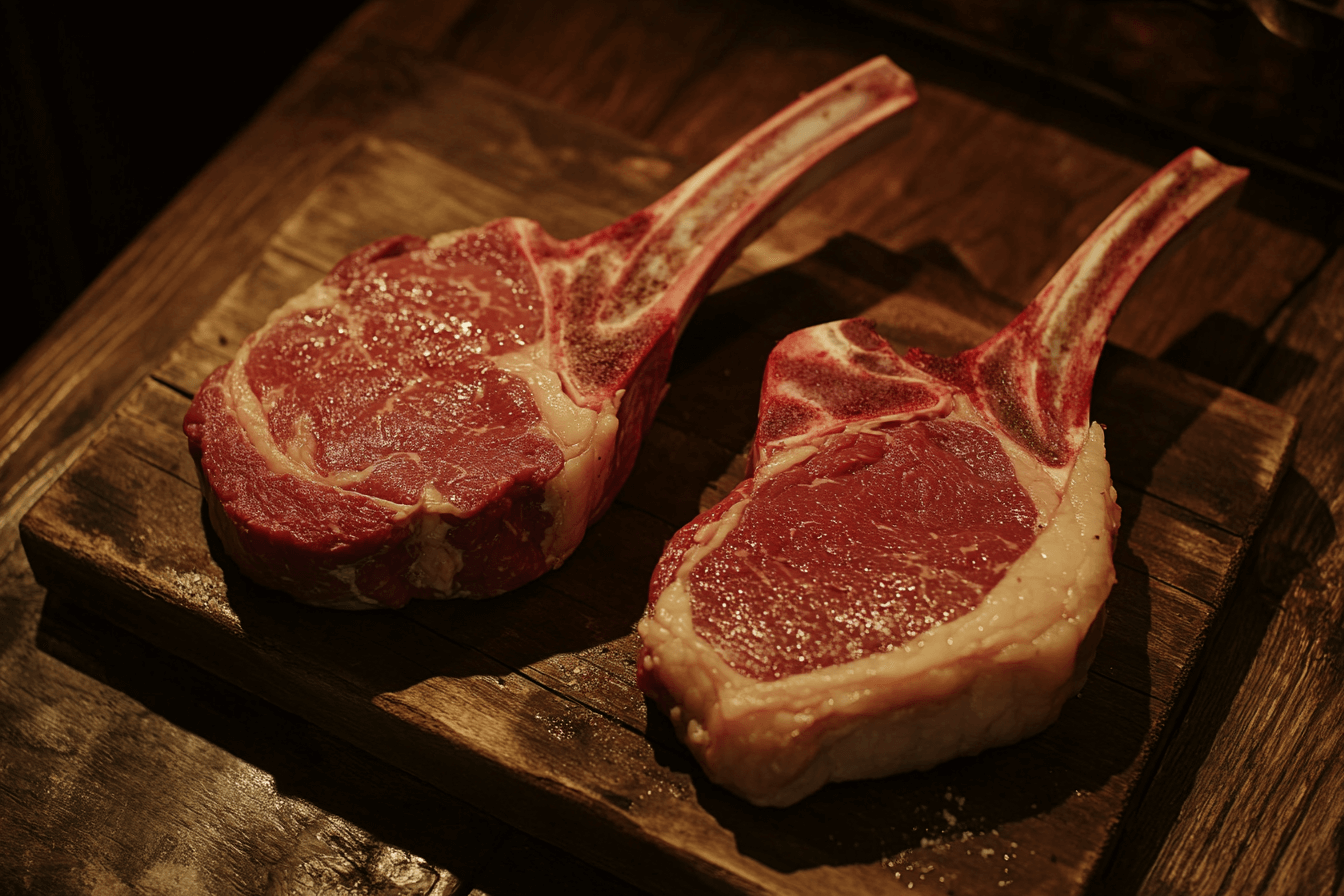Introduction
Steak lovers often seek the perfect cut for a memorable meal. Yet many find themselves confused when trying to pick between the tomahawk steak and the cowboy steak. Both cuts are impressive, flavorful, and sizeable. They also come from a similar section of the beef rib primal. However, they are not exactly the same. Understanding their subtle differences can help you choose which steak suits your taste and cooking style.
In this article, we will explore these two cuts in detail. We will talk about their origins, distinct appearances, and unique cooking methods. Moreover, we will discuss how they differ in flavor, presentation, and cost. This way, you will know what to expect from each one. Also, we will share tips on selecting and preparing these steaks for your next backyard barbecue or special dinner at home.
Furthermore, we will address some commonly asked questions to help you navigate the world of premium beef cuts. Although tomahawk steaks and cowboy steaks both deliver hearty flavors, each has something special to offer. Thus, you can decide which one best meets your needs. In the end, you will feel confident in your ability to identify, cook, and serve these impressive cuts.
Grab your grilling tools and get ready. Let’s dive into the fascinating world of tomahawk and cowboy steaks. We will begin by looking at what each steak brings to the table. Then we will highlight the key contrasts. Finally, we will suggest ways to make the most of your steak experience.
What Is a Tomahawk Steak?
A tomahawk steak is a massive, bone-in ribeye cut. It is usually around two inches thick. This steak includes the long rib bone, which gives it its signature “axe-like” appearance. Many people find that the bone enhances flavor. They also enjoy the striking presentation it offers on the plate. Because of its size, it can be a centerpiece dish at dinner parties or special events.

In most cases, the tomahawk steak is cut from the fore-rib, with the rib bone left fully intact. Butchers remove excess meat and fat from the bone, a process called “Frenching.” This leaves a clean handle that resembles a tomahawk or hatchet. Some refer to it as a “bone-in ribeye with a handle.” Because it is so large, it often weighs between 30 to 45 ounces. That makes it ideal for sharing, although some serious steak enthusiasts might want one all to themselves.
Moreover, the tomahawk steak’s thick cut means it needs a careful cooking approach. It is best to cook it more slowly at first, then finish with a quick sear. This method ensures an even cook throughout. Many chefs use a reverse-sear method. They let it slowly come up to temperature in the oven or on indirect heat. Then they sear it over high heat for a mouthwatering crust.
Furthermore, the tomahawk steak has a high fat content due to its ribeye nature. This marbling delivers rich flavor when cooked correctly. The bone also helps to lock in moisture. That is why many people prefer this cut for its succulent texture. Yet the tomahawk is not just about taste. It also offers visual appeal. The long bone makes it look majestic. Hence, it often becomes the center of attention at gatherings.
Despite its many positive qualities, some note that the tomahawk can be pricier than other ribeye cuts. This higher cost stems from its size, the presentation factor, and the extra care involved in preparing the bone. Still, if you want a special-occasion steak, the tomahawk rarely disappoints.
What Is a Cowboy Steak?
A cowboy steak is also a bone-in ribeye. However, it usually has a shorter bone. This shorter bone is sometimes referred to as a “Frenched bone,” but it lacks the long handle seen in a tomahawk. The cowboy steak typically features part of the rib bone that extends just a few inches from the meat. Although it is still striking, it is more compact than the tomahawk.

The cowboy steak shares many traits with the traditional ribeye. It offers ample marbling, which leads to intense flavor. Because it comes from the same rib primal section as the tomahawk, it has that familiar beefy richness. In fact, some might find these two cuts almost identical when it comes to taste. Yet there are subtle variances in how they cook and appear on the plate.
One main advantage of the cowboy steak is that it is often easier to handle than its tomahawk sibling. It typically weighs around 16 to 20 ounces, although some can be bigger. This size makes it easier to manage on the grill or stove. Moreover, it cooks faster due to its reduced thickness. Many home cooks enjoy it because it requires less time and effort to reach the desired doneness.
Furthermore, the cowboy steak often costs less than the tomahawk. Part of this difference is due to the shorter bone. Another factor is that it is simply more common to see cowboy steaks at grocery stores. Still, it remains an impressive cut. It has a bold flavor, substantial size, and a nice presentation.
If you enjoy the ribeye experience but prefer a bit less hassle, the cowboy steak is a great choice. It retains that classic ribeye taste but in a slightly smaller, more practical form. Nonetheless, it still looks appealing, especially when served bone-in. You can also use many of the same cooking methods that you would use for a tomahawk. Yet you might find it easier to achieve a uniform cook.
What’s the Difference Between a Tomahawk and a Cowboy Steak?
You may still wonder: what exactly sets the tomahawk apart from the cowboy steak? The main difference lies in the length of the rib bone and the overall size. The tomahawk boasts a dramatic, extra-long bone that gives it a unique look. On the other hand, the cowboy steak has a shorter bone. Thus, it is smaller in appearance yet still full of flavor.

Additionally, the tomahawk steak can weigh almost twice as much as a typical cowboy steak. Because of its thickness, you often need more precise cooking techniques. Meanwhile, the cowboy steak’s more modest size allows for faster cooking. This can be beneficial if you are short on time or not as experienced in managing very thick cuts.
Another difference revolves around cost. Tomahawk steaks tend to be more expensive. This is partly due to the added presentation factor. It also requires more trimming labor at the butcher shop. Cowboy steaks, while still premium cuts, usually fall into a more affordable range. If you are eager to try bone-in ribeye without breaking the bank, a cowboy steak may be a smarter choice.
Moreover, the tomahawk’s long bone can impact how you position it on the grill or in the oven. You need more space to accommodate the lengthy handle. In contrast, the cowboy steak fits more easily in a standard pan or grill. Some might also claim that the tomahawk bone imparts a slightly deeper flavor. However, this point is often debated.
Lastly, presentation is a major factor. The tomahawk steak commands attention. It can be a conversation starter. However, the cowboy steak, though smaller, still looks appealing. It provides that same ribeye taste and bone-in experience in a more compact package. Therefore, your choice might hinge on how important presentation is to you.
Tomahawk Steak vs Cowboy Steak: Flavor and Cooking Methods
When comparing tomahawk steak vs cowboy steak, you will find their flavor profiles are quite similar. Both cuts come from the rib primal, which is known for rich marbling and juiciness. Moreover, they respond well to many cooking styles. Grilling, searing, broiling, or even reverse searing are all excellent options. Still, you should consider a few factors before you start cooking.
The tomahawk steak’s thickness means it is better to use a two-step process. First, bring the internal temperature up gently. Then finish with a high-heat sear to create a crust. This technique helps avoid overcooking the outer edges. As a result, you get a tender and pink center. Meanwhile, a cowboy steak is usually thinner. You can cook it more quickly. A direct grill over medium-high heat, followed by a short rest, often yields wonderful results.
Furthermore, seasoning both cuts properly is key. Because they are thick, you need a generous layer of salt and pepper to ensure flavor penetrates the surface. Some people use marinades or rubs that include garlic, onion powder, or herbs like rosemary. You can also experiment with compound butter to top off your steak once it is done.
In terms of flavor, both are equally delicious. The main difference is how long you spend cooking. Tomahawk steak usually requires a bit more skill, since it is large and can be tricky to cook evenly. Cowboy steak is simpler to handle. Yet it still provides the same juicy taste that ribeye fans adore. When you slice into either cut, you will see a nice distribution of fat marbling, which translates to mouthwatering flavor.
Although they are both ribeyes, the presence of the bone can affect the final taste. Some believe cooking meat on the bone adds a subtle depth. Others notice little difference. In any case, both steaks are worth trying, especially if you love bold, beefy flavor with an eye-catching presentation.
Tomahawk Steak vs Cowboy Steak: Cost and Value
Price is another crucial point to consider. Tomahawk steaks often cost significantly more per pound. This is because the cut includes extra processing time and visual appeal. The bone is trimmed and left longer, which some butchers consider a premium service. Furthermore, restaurants often list tomahawk steaks as their high-end menu showpieces. This can drive up the cost.
Cowboy steaks are still premium cuts. However, they tend to be less expensive. They have less “bone real estate,” making them easier to prepare at the butcher shop. Also, since they are smaller, the overall weight is reduced. This translates to a more affordable final price. If you want a bone-in ribeye experience but do not want to pay top dollar, the cowboy steak offers a more budget-friendly route.
Nevertheless, many people are willing to pay extra for the tomahawk’s wow factor. It is popular for special occasions. Birthdays, anniversaries, or holidays are prime times to indulge in the tomahawk. The visual spectacle of a huge bone-in steak can impress guests, particularly those seeing one up close for the first time.
When it comes to value, you need to think about your priorities. If presentation ranks high and you do not mind spending more, the tomahawk is an excellent choice. On the other hand, if you want a similar taste and texture for a lower cost, the cowboy steak might be perfect. Both cuts deliver a fulfilling ribeye flavor, so neither choice is truly wrong.
Also, remember that both steaks serve as hearty meals. Even though the tomahawk is bigger, the cowboy steak can still feed one or two people, depending on the appetite. Thus, consider how many guests you plan to serve. In many cases, you can save money and still delight everyone by choosing a few cowboy steaks. But if you crave an epic showpiece, pick the tomahawk.
How to Select and Serve These Cuts
Choosing between a tomahawk and a cowboy steak often comes down to personal preference. However, there are tips to ensure you pick a high-quality piece. Look for bright red meat with fine marbling. The fat should appear creamy white. Avoid anything with a dull color or an unpleasant smell. Also, check if it is USDA Prime or USDA Choice, which can guide you toward better quality.
When serving, let your steak rest for about 5 to 10 minutes after cooking. This step helps the juices redistribute throughout the meat. For a tomahawk, you can slice it at the table for added drama. This approach allows each guest to see the large bone and appreciate the unique shape. A cowboy steak can be served whole on a plate or pre-sliced if sharing.
Moreover, the sides and sauces you choose can enhance the overall dining experience. Creamed spinach, roasted vegetables, or mashed potatoes often pair well with these cuts. Likewise, a classic béarnaise or peppercorn sauce can add a layer of complexity. Yet these steaks taste amazing with just simple seasonings, thanks to their natural richness.
Additionally, consider your cooking equipment. A thick tomahawk might demand a larger grill or cast-iron skillet. You also want a reliable meat thermometer to monitor doneness. For the cowboy steak, a standard pan or smaller grill space is sufficient. Still, it is wise to keep an eye on the internal temperature. Overcooking can ruin even the finest piece of steak.
Finally, think about slicing technique. For both cuts, slice against the grain. This simple practice keeps the bites more tender. Also, serve them hot. Steak flavor peaks when it is freshly cooked. If you have leftovers, they can make incredible sandwiches or steak salads the next day.
Frequently Asked Questions
Is a tomahawk steak just a ribeye?
Yes, it is essentially a bone-in ribeye with the rib bone intact and frenched for a striking appearance. The extra-long bone is the key difference from a standard ribeye.
Is tomahawk steak the same as prime rib?
No, these are not the same. Prime rib is a roast taken from the rib primal. A tomahawk steak is a single portion, bone-in ribeye that includes the long bone.
What is another name for a tomahawk steak?
Some people call it a “bone-in ribeye with a handle.” Others simply refer to it as a “long bone ribeye.” The tomahawk name comes from its axe-like look.
Are tomahawk and cowboy steak the same thing?
They both come from the rib primal, yet the tomahawk has a longer bone. The cowboy steak has a shorter bone and is usually smaller and faster to cook.
Conclusion
Tomahawk steaks and cowboy steaks share many similarities. Both come from the rib primal and offer that delicious, marbled ribeye flavor. However, they differ in appearance, size, and cost. The tomahawk steals the show with its extended bone, making it a perfect centerpiece for special occasions. Meanwhile, the cowboy steak, though less dramatic, is more convenient to handle and often more budget-friendly.
In the end, your choice may hinge on how you plan to cook, serve, and enjoy your steak. If a grand presentation is your goal, go for the tomahawk. If you prefer quicker cooking and a slightly smaller portion, pick the cowboy steak. Either way, you will savor a hearty, flavorful piece of beef that can elevate any meal. So, the next time you are standing at the butcher counter or planning a weekend cookout, you will know exactly what sets these two cuts apart. Happy grilling and enjoy every bite!

